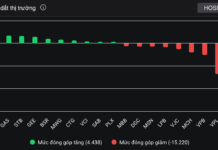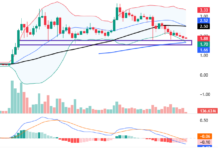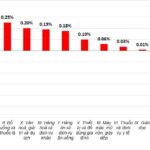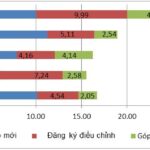According to the General Statistics Office (Ministry of Finance), as of August 6, 2025, the industrial production index (IPI) for July 2505 is estimated to increase by 0.5% compared to the previous month and 8.5% over the same period last year. For the first seven months of 2025, the IPI is estimated to increase by 8.6% year-on-year (compared to 8.5% in the same period in 2024).
Contributing to the overall growth, the manufacturing industry increased by 10.3% (compared to 9.6% in the same period in 2024), contributing 8.5 percentage points; electricity production and distribution increased by 4.6% (compared to 12.0% in 2024), contributing 0.4 percentage points; water supply, waste management, and sewage activities increased by 10.4% (compared to 7.1% in 2024), contributing 0.1 percentage points; and mining decreased by 2.7% (compared to a 6.6% decrease in 2024), resulting in a 0.4 percentage point reduction.
In the first seven months of 2025, several key secondary industries witnessed notable growth in their industrial production indices compared to the same period last year. Specifically, motor vehicle manufacturing increased by 29.9%; rubber and plastic product manufacturing increased by 16.9%; leather and related product manufacturing increased by 15.4%; manufacturing of other non-metallic mineral products increased by 14.8%; apparel manufacturing increased by 14.5%; manufacturing of other transport equipment increased by 12.2%; manufacturing of fabricated metal products (except machinery and equipment) increased by 11.0%; furniture manufacturing increased by 10.9%; metal manufacturing increased by 10.1%; food processing increased by 10.0%; and electronic product, computer, and optical product manufacturing increased by 7.9%.
However, on the downside, some industries recorded low growth or decline in their IPI: beverage manufacturing increased by 3.1%; electrical equipment manufacturing increased by 3.0%; crude oil and natural gas extraction decreased by 8.1%; and pharmaceutical, chemical, and medicinal product manufacturing decreased by 4.9%.
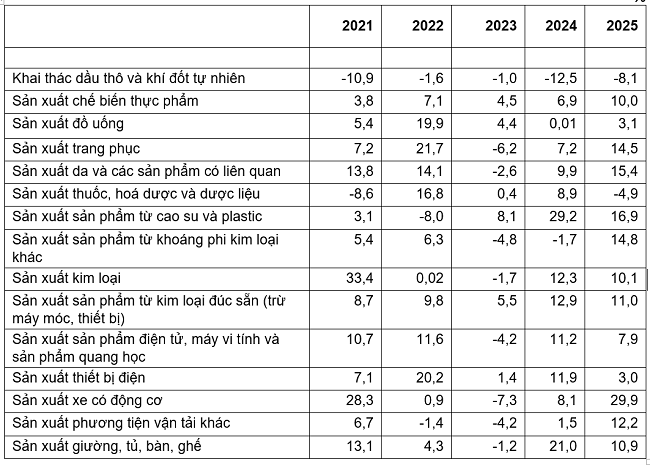
Regarding the IPI of different localities across the country, the report by the General Statistics Office noted increases in all 34 provinces and cities. Specifically, the localities with high growth rates in the IPI of the manufacturing industry in the first seven months of 2025 compared to the same period last year were: Quang Ninh (32.0%), Phu Tho (26.9%), Ninh Binh (23.4%), Lai Chau (20.1%), Thanh Hoa (17.2%), and Hue (16.7%).
The localities with significant increases in the IPI of electricity production and distribution included: Hue (43.2%), Nghe An (27.3%), Lai Chau (17.0%), Quang Ngai (11.9%), and Phu Tho (7.5%).
On the other hand, some localities recorded low growth or declines in their IPI due to low growth or decreases in the manufacturing industry, mining, and electricity production and distribution sectors.
Specifically, the localities with low growth or declines in the IPI of the manufacturing industry in the first seven months of 2025 compared to the same period last year were: Lang Son (3.8%), Ha Tinh (2.5%), and Cao Bang (-7.3%).
The localities with low growth or declines in the IPI of electricity production and distribution in the first seven months of 2025 compared to the same period of 2024 were: Lao Cai (2.4%), Khanh Hoa (1.0%), Lam Dong (0.3%), Ho Chi Minh City (-39.1%), Cao Bang (-4.6%), and Ca Mau (-1.5%).
The locality with a decrease in the IPI of the mining industry in the first seven months of 2025 compared to the same period of 2024 was Ho Chi Minh City (-7.5%). Other localities with decreases included Ca Mau (-5.5%), Hanoi (-4.9%), Lao Cai (-2.5%), and Quang Tri (-13.6%).
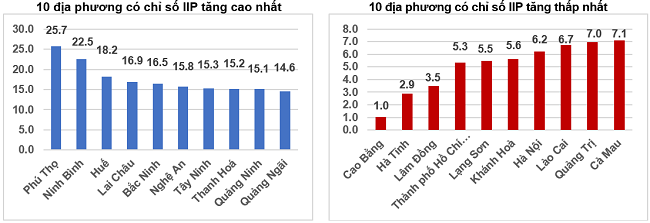
The report by the General Statistics Office also highlighted the growth of the industrial sector in the first seven months of 2025 through the output of various key industrial products. Several products recorded double-digit growth rates, reflecting improving market demand and production capacity.
Specifically, some key industrial products that witnessed growth in the first seven months of 2025 compared to the same period last year included: automobiles (64.4%), televisions (21.1%), NPK compound fertilizer (19.7%), ready-to-wear garments (14.9%), cement (14.8%), leather shoes and sandals (13.6%), aquatic feed (11.9%), rolled steel (11.5%), liquefied petroleum gas (LPG) (11.4%), steel bars and angles (11.0%), and refined circular thread (10.4%).
On the other hand, some products recorded decreases compared to the same period last year: natural gas in gaseous state (12.9%), artificial fiber yarn (5.2%), crude oil (3.1%), and mobile phones (0.4%). These declines reflect the challenges faced by specific industries.
Regarding the employment situation in industrial enterprises, the report by the General Statistics Office also showed positive signals. Specifically, as of July 1, 2025, the number of employees in industrial enterprises increased by 1.0% compared to the previous month and by 3.9% compared to the same period last year. State-owned enterprises recorded a 0.5% increase compared to the previous month and the same period last year; foreign-invested enterprises increased by 1.2% and 4.6%, respectively; and non-state enterprises increased by 0.6% and 2.7%, respectively. This indicates a strengthening of business confidence in production and business prospects.
By industry, the number of employees in mining enterprises increased by 1.2% compared to the previous month and by 1.6% compared to the same period last year; the number of employees in manufacturing enterprises increased by 1.1% and 4.1%, respectively; electricity, gas, hot water, steam, and air conditioning production and distribution enterprises decreased by 0.1% and 0.5%, respectively; and water supply, waste management, and sewage treatment enterprises increased by 0.2% and 1.5%, respectively.
Overall, the industrial production in the first seven months of 2025 continued to grow steadily. Despite challenges in specific industries and products, the general trend indicates that Vietnam’s industrial sector is on the right track, providing a solid foundation for growth targets in the remaining months of the year.
The Great Migration and the Rise of Satellite Megacities
The urban landscape is undergoing a significant shift, with a wave of expansion that is fueling the rise of satellite megacities. These emerging urban centers offer a unique blend of ecological living spaces, world-class amenities, and strong potential for long-term growth, setting a new standard for modern urban development.
How Tycoon Pham Nhat Vuong Is Taking Over Hai Phong With His $2.2 Billion Real Estate, Industrial, and Logistics Projects
With an estimated investment of nearly $22 billion, Vingroup is the largest private investor in Hai Phong, spanning across real estate, industry, energy, and infrastructure sectors. The group has significantly contributed to the city’s goal of becoming the economic center of the northern sea, with its diverse range of projects and developments.
July CPI Rises 0.11% Month-Over-Month
According to the latest data released by the Statistics Bureau, the consumer price index (CPI) rose 0.11% in July from the previous month, primarily due to increases in housing maintenance material prices, food prices, and dining out. The CPI for July increased by 2.13% compared to December 2024, and by 3.19% year-on-year. On average, in the first seven months of 2025, the CPI rose by 3.26% year-on-year, with core inflation up by 3.18%.
“VinFast’s Progress in India Two Years After Meeting with Indian Billionaire: A $10 Billion Investment Prospect”
The Adani Group has strong ties to the automotive industry, particularly in the realm of electric vehicles (EVs) and clean transportation solutions.
Attracting FDI in the Past 7 Months Surpasses $24 Billion, Up 27.3% Year-on-Year
As per the latest statistics released by the Foreign Investment Agency, foreign investment registered in Vietnam as of July 31, 2025, including newly registered, adjusted, and contributed capital, and share purchases by foreign investors, amounted to an impressive $24.09 billion, marking a significant 27.3% increase compared to the same period last year.

















